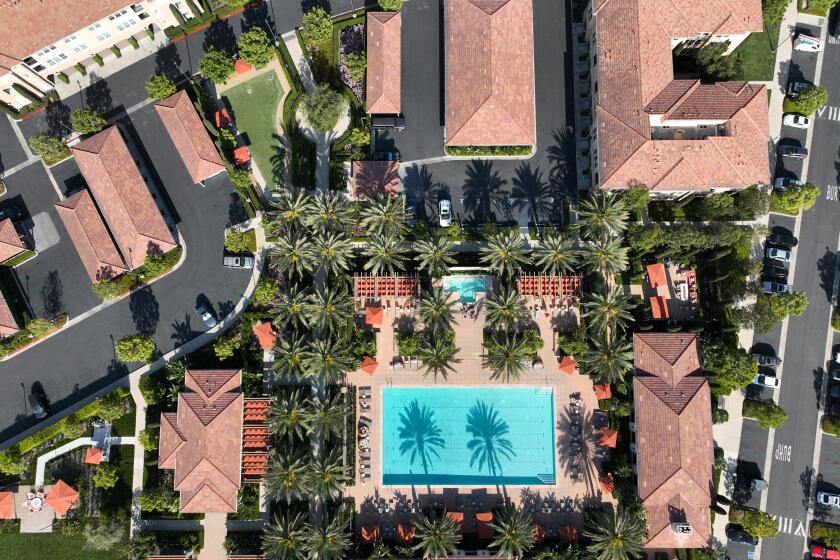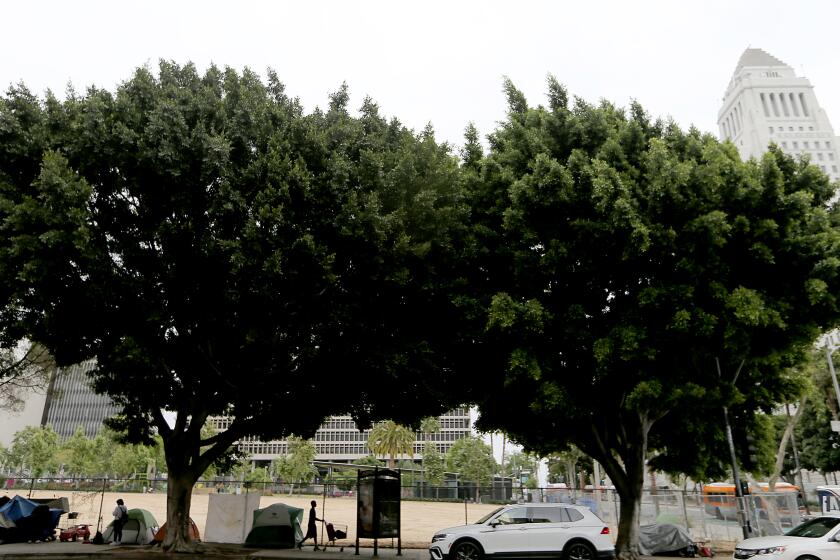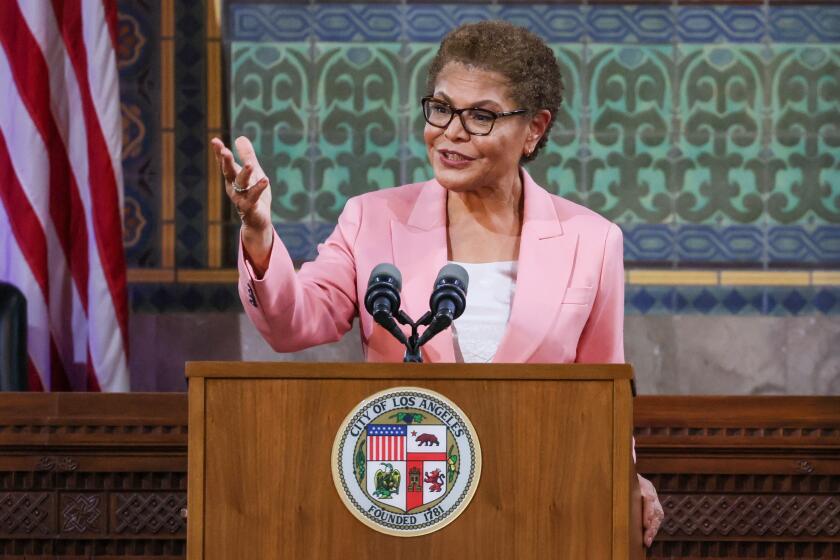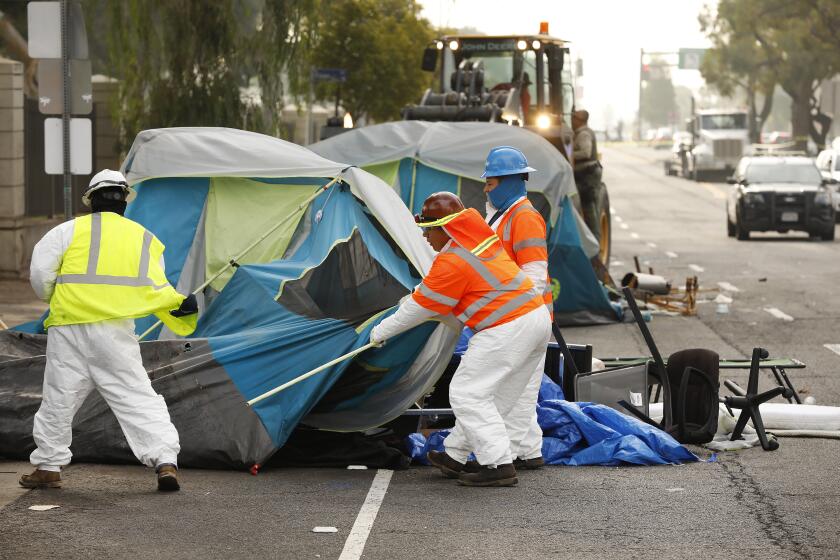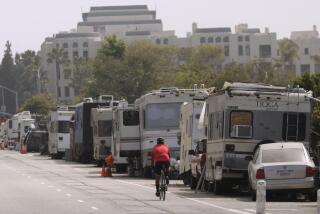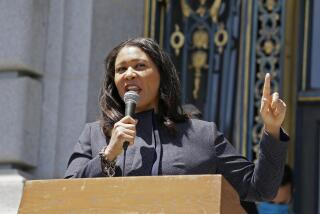After the city removed RVs from Forest Lawn Drive, it also banned parking — for everyone
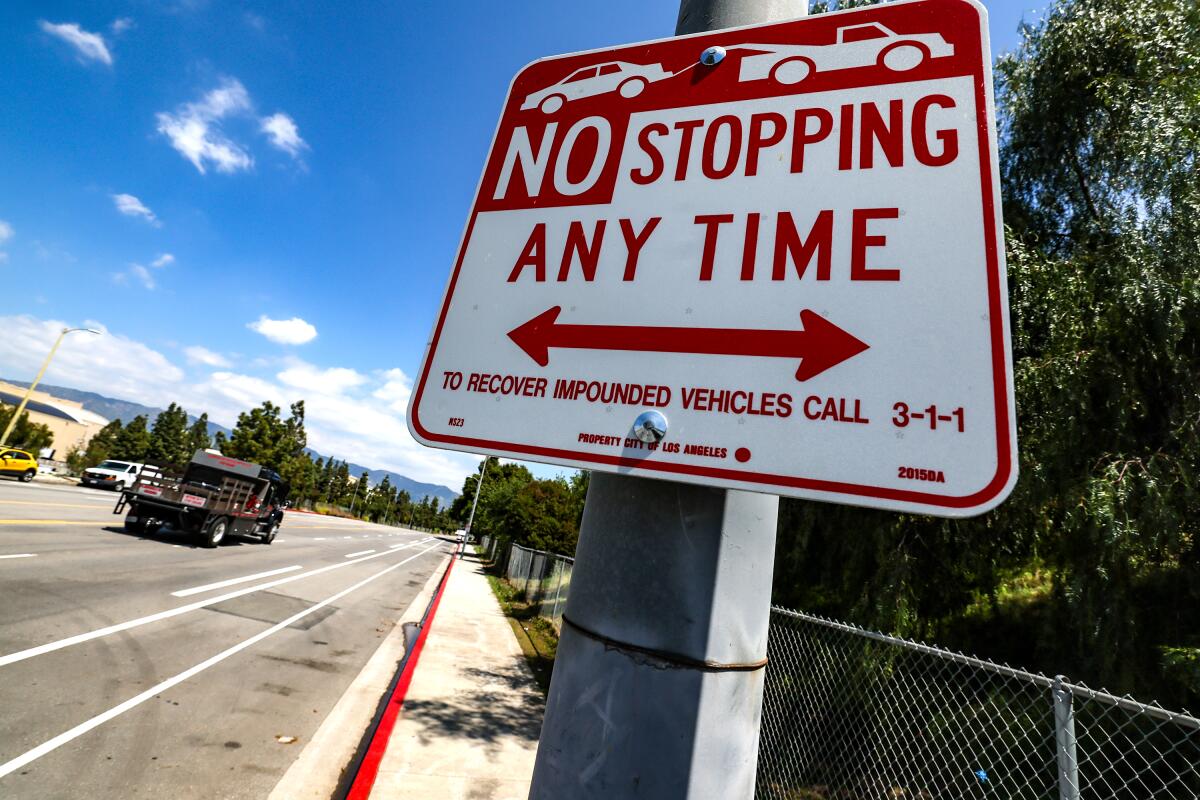
- Share via
Nancy Sexton was elated when city crews in December cleared more than 50 RVs that had stood near her business for months, blocking parking spots and leaving trash and waste on Forest Lawn Drive.
Then she realized that the long stretch of road near Barham Boulevard in the Hollywood Hills was suddenly off limits for all parked vehicles. Much of the curb was painted red, and “no parking” signs lined the sidewalk.
“It’s a dumb decision,” said Sexton, who owns the Muse Rooms, which offers leased office spaces. “It’s frustrating.”
The RVs, which had been stationed along the winding road for months as a semi-permanent encampment, were removed in December as part of the city’s Inside Safe program.
One goal of the program, which is part of Mayor Karen Bass’ initiative to bring unhoused people indoors, is to end the cycle of encampments being cleared by the city, only to return a few weeks later.
But days after the RVs were removed, Sexton said, parking became limited. The new red zone stretches about a quarter mile, between Warner Bros. Studios’ Gate 9 entrance and North Coyote Canyon Drive. The areas that do allow parking have two-hour limits.
After adding 12 this year, California accounts for 210 of the country’s 550 cities where the typical home value is more than $1 million, according to an analysis by Zillow.
City officials said the decision to restrict parking was based on fire safety concerns, not to keep RVs from resettling along the road.
Sexton has doubts. The lack of parking along the street imposed an unexpected expense on her clients, prompting some to look elsewhere, she said. The red curb is an irritation also for students and workers at the New York Film Academy and nearby businesses.
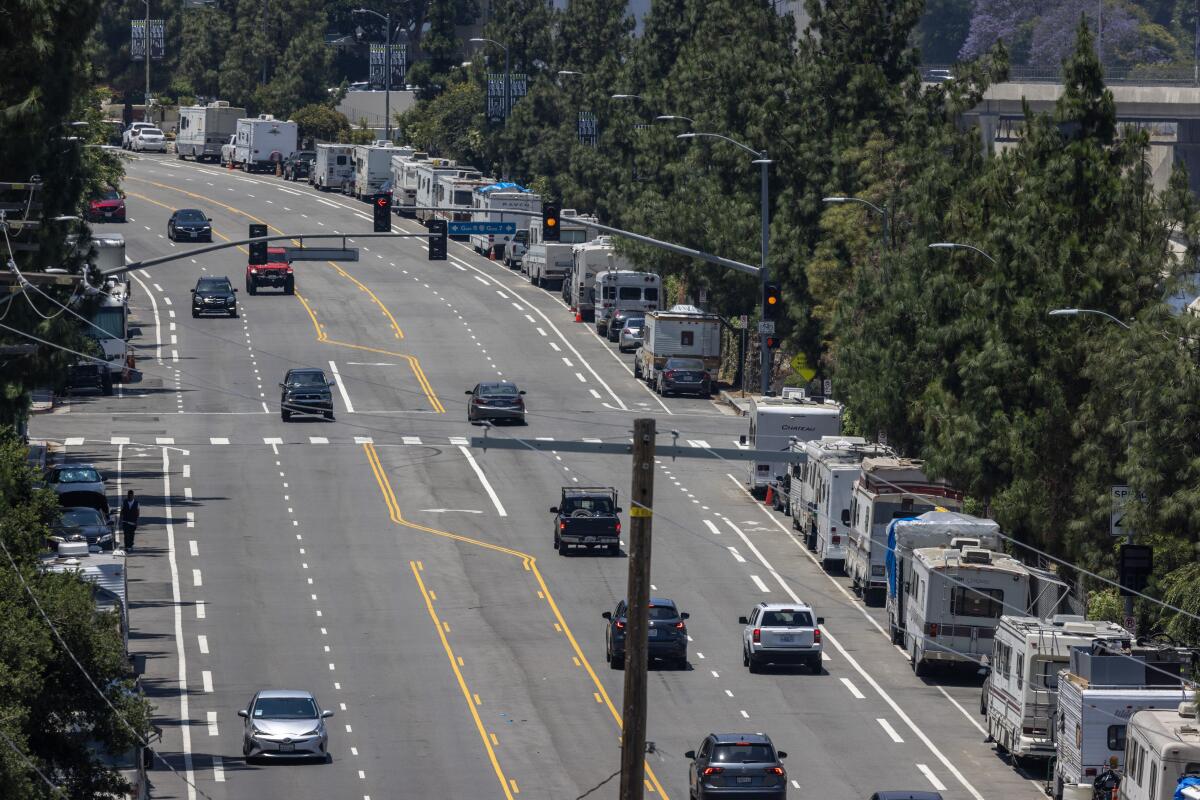
Sexton said she has lost two regular members and two potential clients since parking was restricted. All aired concerns about the lack of street parking and the expense of paying $12 a day at the on-site parking structure.
The parking fee doubles monthly costs for some members, Sexton said.
“I didn’t know how much of a problem it was going to be until there were people saying, ‘I can’t pay $12 a day,’” she said. “I’m really feeling it now.”
The situation highlights the unintended results as city officials look to address homelessness and the concerns of businesses and homeowners about makeshift encampments involving tents or vehicles.
RV encampments have sprung up amid a housing crisis that has left many people priced out of permanent homes. Local officials have looked for ways to address the issue, including implementing regulations that target overnight RV parking.
According to the mayor’s office, Inside Safe has addressed 39 encampments, moving more than 2,400 people into interim housing and 440 into permanent housing since December 2022.
The removal of the RVs on Forest Lawn Drive was first reported by Los Angeles Public Press.
A leak purportedly exposed systemic failures of Los Angeles’ anti-camping law, reigniting a debate on the City Council. The reality on the streets is more complex.
Bass spokesperson Zach Seidl said the RVs that were removed from Forest Lawn Drive were causing parking issues and raising significant safety and public health concerns.
Members of the community have said removing the RVs “has helped on all three fronts,” Seidl said in a statement. “This operation has saved lives.”
Stella Stahl, spokesperson for Councilmember Nithya Raman, said the city has helped many of theRV residents find housing indoors.
In a statement, Stahl credited the decision to limit parking to a request by the Los Angeles Fire Department, which called the area a “high fire severity zone.” A 2019 brush fire there burned more than 30 acres and threatened homes and businesses.
In a Sept. 19 letter, LAFD Assistant Chief Dean Zipperman asked the city Department of Transportation to install “no parking” restrictions on the road due to the stopped vehicles.
To avoid the hassle of looking for parking, students Sanchin Vinay, Yifan Xiang and Davide Picci carpool to classes at the New York Film Academy, which shares a building with the Muse Rooms.
Eliminating the RVs has opened some spots to them, although Picci said they were able to find spaces on the street before — “really far down.”
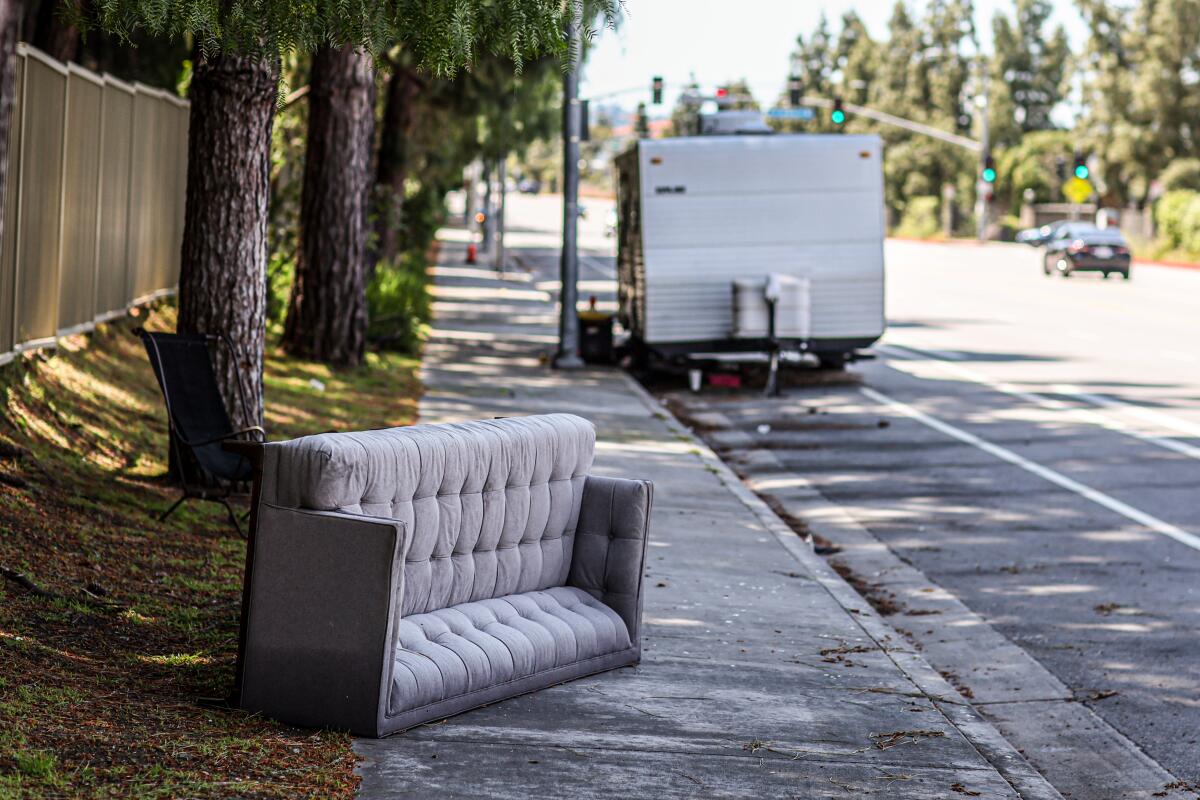
Sometimes they pay $12 for daily parking to avoid being late for class.
Leslie Bates, a film production instructor, said she had heard of students and faculty members having “volatile” interactions with the RV residents.
She said she finds that the city hasn’t been enforcing the two-hour parking limit or red zones along Forest Lawn Drive, and people park there regardless.
Stahl said Raman’s office has received only one complaint about the parking change. Nevertheless, the office and the Department of Transportation are discussing modifying the two-hour parking zones.
Some businesses in the area had already taken a toll from the RV encampment.
The pitch comes as Bass is working to break a logjam that has limited the city’s ability to move homeless Angelenos out of hotels and into apartments they can afford.
Marie Landsberger, a fitness manager at Toluca Lake Tennis & Fitness Club, said parking began to be an issue after the onset of the COVID-19 pandemic, when RVs and trailers started staying on Forest Lawn Drive.
At least one person canceled a membership after saying they had to step over a man sleeping on the street, Landsberger said. Others complained that the encampment, with its tarps and trash, was an eyesore.
“They weren’t following the rules; they were just dumping tanks on the street,” Landsberger said. “There was feces floating down the sidewalk.”
The fitness club has parking for members, but employees struggled to find spots on the street.
“I don’t miss them,” Landsberger said of the RV residents. “They frightened our members.”
Landsberger said she doesn’t mind the new restrictions because the red zone is on the opposite side of the street from her business and doesn’t affect it much.
“We don’t encourage people to walk across the street anymore. It’s too dangerous,” Landsberger said of the speedy cars driving down the five-lane road. Most members and employees opt to park on the side of the club instead of trying to jaywalk across the street.
“It’s like a freeway through here,” she said.
A federal judge has found that Los Angeles city officials altered evidence in a case alleging that the city illegally seized and destroyed homeless people’s property.
Sexton said she was initially glad that the city had addressed the encampment but grew frustrated as the consequences of the parking restrictions became apparent. She’s in the third year of a 10-year lease, she said, and if public parking had not been available for her members, she probably would not have opened her business there.
“Imagine you’re coming in, and you’re paying $250 a month for your co-working spacing, and you come in and you can’t find parking,” she said. “You leave.”
More to Read
Sign up for Essential California
The most important California stories and recommendations in your inbox every morning.
You may occasionally receive promotional content from the Los Angeles Times.
